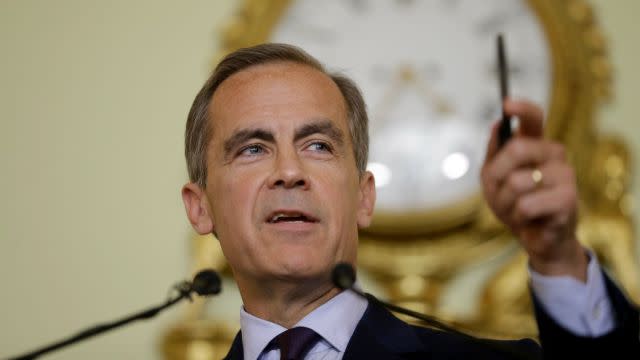Britain’s knight in shining armor is…Canadian Mark Carney

In the aftermath of Britain’s referendum vote to leave the European Union, Brexit’s loudest advocates scurried from public view and the political establishment descended into a caustic battle for control. Emerging from the melee was Theresa May, who has a reputation for consistency, if little else. But the UK doesn’t need a caretaker in these uncertain and turbulent times. It needs bold and innovative leadership.
One person has quietly stepped up into the role: Canadian Mark Carney, the governor of the Bank of England. Carney acted quickly to stem the panic from Brexit. Now he can and should do more. The list of challenges is daunting: prevent a recession from becoming a depression, preserve London’s preeminence as a financial capital, jump-start entrepreneurship, and make the economy work for everyone, not just a few. In normal circumstances, a central bank would take on one or two of these.
These are exceptional circumstances. Now is Carney’s moment to chart a new path for a more prosperous and dynamic United Kingdom. To do so, he must continue to embrace financial technology (fintech) and hasten the bank’s implementation of the blockchain—the vast, globally-distributed ledger in which anyone anywhere can move, store, and manage any kind of asset, from money and securities to intellectual property and votes, securely and privately without a trusted intermediary like a bank or government. Blockchain is the first digital medium for value, just as the internet was the first for information.
On June 16th, the Bank of England quietly published Carney’s Mansion House speech, the bank’s most important. In it, he laid out an ambitious vision for how fintech and blockchain could transform the global financial system and UK economy. He argued, “For everyone, fintech may deliver a more inclusive financial system, domestically and globally; with people better connected, more informed, and increasingly empowered.”
Carney also announced the bank was piloting a central bank digital currency project. With a “Britcoin,” the Bank of England could better defend against crises like Brexit, prevent financial crimes, encourage honest competition, foster innovation and financial inclusion, and boost growth. In a more recent paper published July 20, 2016, the Bank of England said replacing 30% of the currency in circulation with a central bank digital currency would “permanently raise GDP by as much as 3%” and “substantially improve the central bank’s ability to stabilize the business cycle.”
Carney is not the first central banker to suggest a central bank digital currency. The Bank of Canada recently announced a digital Canadian dollar pilot, in partnership with Canada’s biggest banks and the blockchain innovation firm, R3. As early as 2013, Ben Bernanke said that blockchains could “promote a faster, more secure, and more efficient payment system.”
Blockchain promises to improve the three critical roles of central banks. First, they manage monetary policy by setting interest rates and controlling the money supply. Second, they maintain financial stability by acting as the lender of last resort and as the banker for governments and other banks in the system. Finally, they often share the burden of regulating the financial system and economy.
Let’s start with financial stability. In his Mansion House speech, Carney said fintech “has the potential to affect monetary policy transmission, the safety and soundness of the firms we supervise, the resilience of the financial system, and the nature of shocks that it might face.” According to Carolyn Wilkins, deputy governor of the Bank of Canada, a central bank digital currency would empower central banks to respond more quickly to systemic shock, gauge the efficacy of monetary decisions, and add transparency to financial markets.
What about central banks as regulators and watchdogs? The traceability and immutability of blockchain technology would improve systemic stability. Armed with perfect information, regulators could use “a lighter touch,” as Jesse McWaters of the World Economic Forum argues. Blockchain innovations like so-called triple-entry accounting, where a third time-stamped entry (alongside debits and credits) gets posted to a blockchain, would give regulators the 20/20 vision they need to manage risk and prevent wrongdoing.
How could blockchain transform monetary policy? Consider a hypothetical: In the wake of the next calamity (say an Italian banking crisis), Mr. Carney decides to cut benchmark rates to give the economy a boost. Today, a central bank must wait days, weeks, even months to see results. Carney argued that, with fintech and blockchain,
[…] big data techniques could tell us about the state of the economy more accurately and promptly. Forecast performance could improve, akin to the forecast improvements that better measurement of atmospheric conditions has, over time, delivered for meteorologists.
So we won’t need a weatherman to know which way the wind blows.
Carney has done much to seed this fintech and blockchain revolution; now he is in an extraordinary position to lead it. He cannot do it alone. The private sector, civil society, and others must also embrace this technology. Recently, the House of Lords convened a group of leading blockchain stakeholders, including deputy governor Dr. Ben Broadbent and industry leaders like Blythe Masters, CEO of the blockchain company Digital Asset Holdings. Other central banks must also step up. Wilkins agreed: “The Bank of Canada must work with other central banks on understanding this technology and what it means.”
Deeper collaboration and decisive action—not white papers—will bring about change. To paraphrase Winston Churchill: never let a good currency crisis go to waste.
A version of this article also appears at The Globe and Mail. You can follow Alex on Twitter at @alextapscott. We welcome your comments at ideas@qz.com.

Sign up for the Quartz Daily Brief, our free daily newsletter with the world’s most important and interesting news.
More stories from Quartz:

 Yahoo Finance
Yahoo Finance 